This site is made possible by member support. ❤️
Big thanks to Arcustech for hosting the site and offering amazing tech support.
When you buy through links on kottke.org, I may earn an affiliate commission. Thanks for supporting the site!
kottke.org. home of fine hypertext products since 1998.
Entries for July 2015
Mad Men Carousel: The Complete Critical Companion

One of my favorite movie/TV critics, Matt Zoller Seitz, is coming out with a book this fall on Mad Men called Mad Men Carousel: The Complete Critical Companion.
Mad Men Carousel, authored by Abrams’ bestselling author Matt Zoller Seitz, will gather all of Seitz’s widely read (and discussed) Mad Men essays in a single volume. Rather than simply recalling the plot through lengthy summary, Seitz’s essays dig deep into the show’s themes, performances and filmmaking, with the tone and spirit of accessible, but serious, film or literary criticism. This novel-sized volume will be designed to have a 1970s feel and will be broken into seven sections, one for each season.
Seitz wrote the dreamy The Wes Anderson Collection.
Louis CK: Of course… But maybe?
This four-minute bit by Louis CK puts me on the floor every time I watch it and then makes me feel really horrible.
Everybody has a competition in their brain of good thoughts and bad thoughts. Hopefully, the good thoughts win. For me, I always have both. I have like the thing I believe, the good thing, that’s the thing I believe and than there’s this thing. And I don’t believe it, but it is there. It’s always this thing and then this thing. It’s become a category in my brain that I call “of course, but maybe”.
I love his gestures throughout this bit…the material is great but the physical comedy really sells it. So so good. (And, of course, terrible.)
The Making of Stanley Kubrick’s ‘2001: A Space Odyssey’
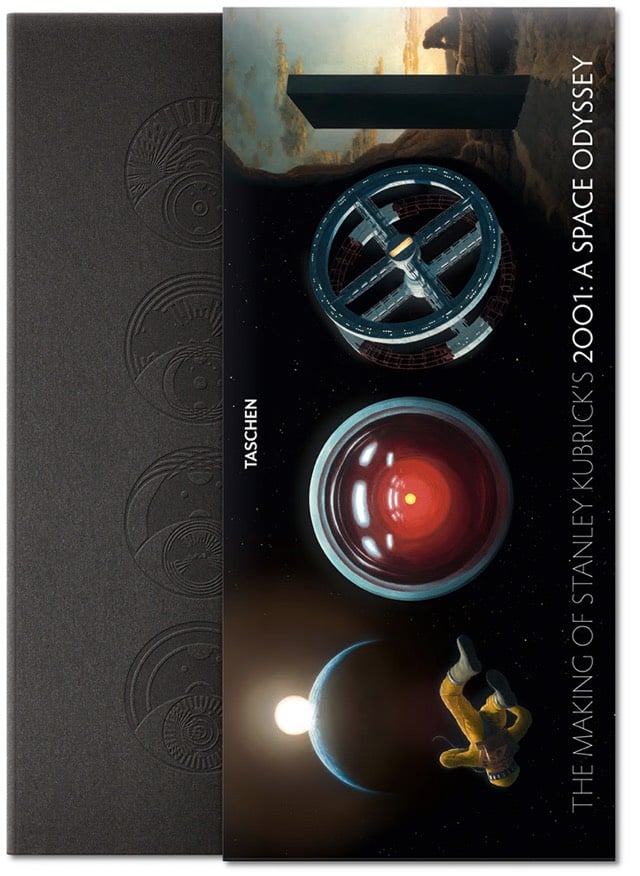
Last year, Taschen came out with a limited edition book on The Making of Stanley Kubrick’s ‘2001: A Space Odyssey’. Only a couple thousand were made and one of them is selling on Amazon for $1750. This year, they’re releasing a regular edition for a much more reasonable $47. (via @michaelbierut)
Hysterical Literature
Photographer Clayton Cubitt started a project in 2012 called Hysterical Literature. In each of the project’s resulting videos, a female participant is filmed from the waist up reading a story of her choosing while she is stimulated to orgasm with a vibrator by Cubitt’s partner, Katie James. His first subject was adult film star Stoya; her thoughts on the experience are here.
Vanity Fair recently sent writer Tony Bentley to participate in an HL session. Her reading choice? The Portrait of a Lady by Henry James.
With Katie now in position under the table, takeoff is imminent and the stakes are high: the sessions are a one-shot deal, no retakes, and no editing of the footage after the fact. It was not lost on me that a perfect triangulation between Clayton (auteur, cameraman), Katie (Hitachi artist), and me (the canvas) was in play, and it mirrored my internal mixture of curiosity, exhilaration, and stage fright. I couldn’t help wondering if this adventure qualified as having a threesome with two strangers. But soon enough such intellectualizing sexualizing was rendered naught.
“Rolling,” says Clayton, and everything instantly disappeared except the book in my hands and the words on the page. The world was out and I was on.
By the time I’d read two pages, I was struggling mightily to keep my countenance. “She spent half her time in thinking of beauty, bravery and mag-nan-nnn-im-im-ity…”
There’s no nudity in the videos, but you might still find them NSFW.
An appreciation of the ShackBurger

From The Message is Medium Rare, an appreciation of the ShackBurger, “a straightforward, honest-to-goodness burger”. It includes a review of the typography used by the restaurant:
These three typefaces artfully express the ethos of both the burger and the brand. Neutraface is the bun: sturdy, reliable and architectural. Futura is the patty: basic but bold. Galaxie is the lettuce: wavy, quirky and fresh. To the layperson this comparison may seem like a stretch, but designers know they are purposefully expressive.
Maps of the United States of Swearing
Most everyone in the United States swears, but the specific words used vary by region. For example, “fuck” is popular in California but not so much in Oklahoma, which is the “crap” epicenter of America. “Motherfucker” is unusually popular in Maine, as is “shit” in the Southeast, “douche” in Iowa, and “fuckboy” in Jersey.



The Bridge at Q’eswachaka
Each year, using traditional Incan techniques, communities along a canyon in Peru rebuild a rope bridge that has been in continuous use for hundreds of years.
That you can take thousands of thin grass stalks and, through the careful application of engineering and hard work, make them strong enough to hold the weight of several people over a canyon still seems magical. (via cynical-c)
Cool furniture alert: the Fibonacci Shelf
The Fibonacci Shelf by designer Peng Wang might not be the most functional piece of furniture, but I still want one.


The design of the shelf is based on the Fibonacci sequence of numbers (0, 1, 1, 2, 3, 5, 8, 13, 21, …), which is related to the Golden Rectangle. When assembled, the Fibonacci Shelf resembles a series of Golden Rectangles partitioned into squares. (via ignant)
Renaissance painting shows how watermelons looked before selective breeding
A painting of fruit done by Giovanni Stanchi sometime in the mid 1600s shows that the watermelon has changed somewhat in the intervening 350 years.

That’s because over time, we’ve bred watermelons to have the bright red color we recognize today. That fleshy interior is actually the watermelon’s placenta, which holds the seeds. Before it was fully domesticated, that placenta lacked the high amounts of lycopene that give it the red color. Through hundreds of years of domestication, we’ve modified smaller watermelons with a white interior into the larger, lycopene-loaded versions we know today.
(via @robinsloan)
Modernizing the NYC subway’s ancient technologies
This video from the MTA shows some of the vintage technologies that are still in use to control many of the NYC’s subway lines and how they are upgrading (ve. ry. slow. ly.) to safer and more reliable computerized systems. Some of control systems are more than 80 years old.
Whoa, after watching that, I’m shocked that the trains ever get anywhere at all. (via the kid should see this)
Update: The NY Times has a look at the political and logistical challenges related to upgrading the NYC subway’s antiquated infrastructure.
A computerized signal system like C.B.T.C. is also safer because trains can be stopped automatically. New York’s quest to install the new system began in 1991, after a subway derailment at Union Square in Manhattan killed five people. The train operator was speeding after he had been drinking.
More than 25 years later, the authority has little to show for its effort to install modern signals. The L line began using computerized signals in 2009 after about a decade of work. A second line, the No. 7, should have received new signals last year, but the project was delayed until the end of this year.
The process is complicated. It requires installing transponders every 500 feet on the tracks, along with radios and zone controllers, and buying new trains or upgrading them with onboard computers, radios and speed sensors. The authority also had to develop a design and software that was tailored to New York’s subway.
Over the years, the authority has kept pushing back the timeline for replacing signals. In 1997, officials said that every line would be computerized by this year. By 2005, they had pushed the deadline to 2045, and now even that target seems unrealistic.
40 years to upgrade the entire system? Embarrassing.
The sounds of Voyager’s Golden Record
When they were launched in 1977, the two Voyager spacecraft each carried with them a 12-inch gold-plated copper record containing images and sounds of Earth for the viewing pleasure of whichever aliens happened across them. NASA has put the sounds of the Golden Record up on Soundcloud. Here are the greetings in 55 different languages (from English1 to Hittite to Polish to Thai):
And the sounds of Earth (wild dogs, Morse code, trains):
What’s missing from the two playlists is UN Secretary General Kurt Waldheim’s greeting:
…as well as several other UN greetings overlaid with whale sounds:
Due to copyright issues, also missing are the 90 minutes of music included on the record. Among the songs are Johnny B. Goode by Chuck Berry, The Rite of Spring by Stravinsky, and Dark Was the Night, Cold Was the Ground by Blind Willie Johnson. Here Comes the Sun by The Beatles was originally supposed to be included, but their record company wouldn’t allow it, which is pretty much the most small-minded thing I have ever heard.
The English greeting was spoken by Nick Sagan when he was six years old. Nick is the son of Carl Sagan, who chaired the committee that selected the contents of the record.↩
Jon Stewart, political heavyweight
Jon Stewart visited the White House. And Obama visited The Daily Show. That gives you some idea of the influence — on both sides of the aisle — Jon Stewart has built up over his tenure.
Jon Stewart slipped unnoticed into the White House in the midst of the October 2011 budget fight, summoned to an Oval Office coffee with President Barack Obama that he jokingly told his escort felt like being called into the principal’s office.
Rappin’ to the Beat
In 1981, ABC’s news program 20/20 aired a segment on the rising phenomenon of rap music called Rappin’ to the Beat. It is painful to watch in parts, but ultimately worth it for the footage of street scenes and artist performances.
Here is part 2. (via open culture)
Why medieval painting babies were ugly
I had no idea Ol’ Dirty Bastard and medieval paintings had something in common. One of ODB’s AKAs was also the reason why babies in medieval paintings looked like ugly middle-aged men: Big Baby Jesus.
I mean, this baby looks like he wants to tell you that a boat is just a money pit.
Biker lifts parked car out of bike lane
How many times have you seen a car parked in the bike lane and wanted to somehow move it out of the way? Well, this very large cyclist felt that way and lifted this small car right out of his way.
I would love to see someone do this to an NYPD cruiser.1
It’s a total cliche, but right now in NYC, I can almost guarantee there are 2 or 3 NYPD cars parked in the bike lane outside a Dunkin Donuts. I see this at least twice a week, just randomly walking around.↩
How bow-tie pasta is made…in slow motion
From Zerega Pasta, a video that shows, in slow motion, how farfalle (aka bow-tie pasta) is made at their factory.
Incredible combination of precision and quickness.
Pixar: The Design of Story
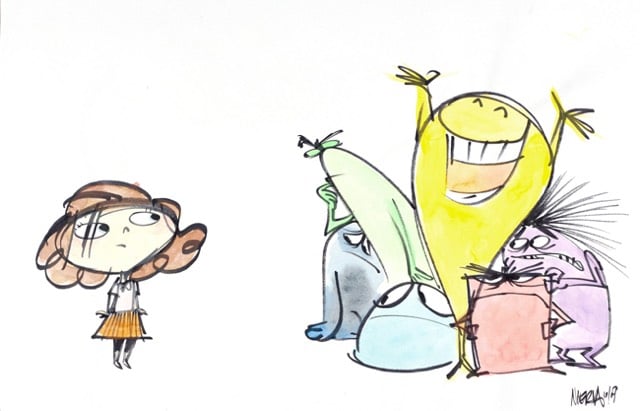
Pixar: The Design of Story is an upcoming exhibition at the Cooper Hewitt National Design Museum here in NYC.
Through concept art from films such as Toy Story, Wall-E, Up, Brave, The Incredibles and Cars, among others, the exhibition will focus on Pixar’s process of iteration, collaboration and research, and is organized into three key design principles: story, believability and appeal. The exhibition will be on view in the museum’s immersive Process Lab — an interactive space that was launched with the transformed Cooper Hewitt in December 2014 — whose rotating exhibitions engage visitors with activities that focus on the design process, emphasizing the role of experimentation in design thinking and making.
More details are available in the press release. Definitely going to check this out and take the kids.
Powers of Ten flipbook
Using images found on the internet through Google’s visually similar images feature, NASA, U.S. Geological Survey, and various mapping services, Kelli Anderson recreated part of the Eames’ iconic Powers of Ten as a flipbook. Watch a video here:
Or play around with a virtual flipbook at Anderson’s site. This could not possibly be anymore in my wheelhouse. Here’s the nitty gritty on how she made it happen.
The inspiration for making discontinuous-bits-of-culture into something continuous goes back to 2011. Some of my friends camped out on a sidewalk to see Christian Marclay’s The Clock. Like a loser with a deadline, I missed out-only catching it years later at MoMA. In the day-long film, Marclay recreates each minute of the 24-hour day using clips from films featuring the current time-on a clock or watch. It runs in perfect synchronization with the audience’s day (so: while a museum crowd slumps sleepily in their chairs at 6am, starlets hit snooze on the clocks onscreen.)
Mike Monteiro: guns can’t be well designed. “If a thing is designed to kill you, it is, by definition, bad design.”
NYC! Don’t sleep on this! Christopher Nolan in conversation w/ Quay Brothers, Aug 19 at Film Forum
Trailer for a Steve Jobs documentary
There’s a documentary on Steve Jobs coming out called Steve Jobs: The Man in the Machine. The director is Alex Gibney, who directed the excellent Going Clear (about Scientology), We Steal Secrets (about Wikileaks), and Enron: The Smartest Guys in the Room. The trailer:
Thom Yorke sings a pre-Radiohead version of High and Dry
While the members of On A Friday, the band that later became Radiohead, were on a break as they attended college, Thom Yorke was a member of a band called Headless Chickens. This is a video of a circa-1989 performance by the band of “High and Dry”, a song that later on Radiohead’s second album, The Bends, released in 1995.
The origin of sci-fi movie sounds
From Aaron Reese at Hopes&Fears, a piece on sci-fi movie sound effects. It’s chock full of interesting tidbits, like where King Kong’s chest-beating sound came from:
Initial attempts hitting a fixed kettle drum with paddled-drumsticks didn’t work, with Spivak saying the sound wasn’t “fleshy” enough. An experiment beating the floor failed as well. So Spivak decided to beat one of his assistant’s chests with drumsticks instead, saying “If wood will not take the place of flesh, then let’s use flesh.” Sure enough, this was the sound used for production.
The stabbing noise in Psycho is a knife plunging into a melon:
In a recording studio, prop man [Bob] Bone auditioned the melons for Hitchcock, who sat listening with his eyes closed. When the table was littered with shredded fruit, Hitchcock opened his eyes, and intoned simply: “Casaba.”
And my favorite, from Terminator 2:
In Robert Patrick’s T-1000 prison break scene, the robot phases through the cell bars with a slurpy metallic sound. Oscar-winning sound designer Gary Rydstrom revealed the effect was achieved by a simple solution from the sound of dog food being slowly sucked out of the can.
The Art of the Car Chase
Casper Christensen cut together footage from dozens of movie car chases into one big coherent chase. Well, as coherent as you can get when you’re dealing with car chases.
There’s some fun and clever editing in here…I particularly enjoyed the stitching together of Indiana Jones and Axel Foley. And I loved the brief clip of C’était un rendez-vous, which if you haven’t seen it, is a quick and thrilling watch.
Muji’s minimalist white toaster
I think I’m a little bit in love with Muji’s white toaster, designed — along with a few other new items — by Naoto Fukasawa.

Fukasawa also designed Muji’s wall-mounted CD player. The toaster is only available at select stores in the US for now, but can be found in the UK and Europe in a few months. Or buy it now on eBay. (via @daveg)
Tree of 40 Fruit
Artist Sam Van Aken is using grafting to create trees that bear 40 different kinds of fruit. National Geographic recently featured Van Aken’s Tree of 40 Fruit project:
The grafting process involves slicing a bit of a branch with a bud from a tree of one of the varieties and inserting it into a slit in a branch on the “working tree,” then wrapping the wound with tape until it heals and the bud starts to grow into a new branch. Over several years he adds slices of branches from other varieties to the working tree. In the spring the “Tree of 40 Fruit” has blossoms in many hues of pink and purple, and in the summer it begins to bear the fruits in sequence — Van Aken says it’s both a work of art and a time line of the varieties’ blossoming and fruiting. He’s created more than a dozen of the trees that have been planted at sites such as museums around the U.S., which he sees as a way to spread diversity on a small scale.
(via colossal)
Human body hair flow maps
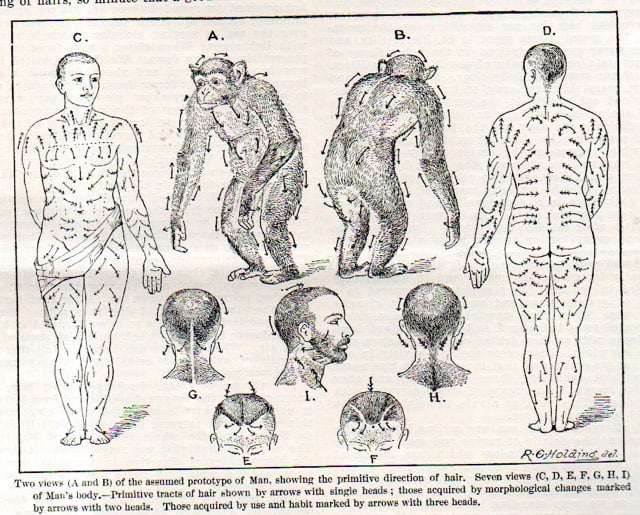
In 1902, Dr. Walter Kidd published this map of “human hair streams”, showing in which directions hair in various parts of the human body grows.
Designers’ summer reading picks
Wired asked a bunch of noted designers — Paola Antonelli, John Maeda, Jessica Walsh, Milton Glaser, etc. — for their summer reading picks. Among their selections were Flow by Mihaly Csikszentmihalyi, An Engineer Imagines by Peter Rice, The Success and Failure of Picasso by John Berger, and Just Enough Research by Erika Hall.
Magic Mike XXL embraces strip club classics
In Pitchfork, Susan Shepard writes about how Magic Mike XXL uses strip club music to full advantage.
MMXXL functions more like a musical in that it uses the dance sequences deliberately to advance the plot; Mike doesn’t talk about wanting to get the band back together, he dances about it when “Pony” comes on in his workshop. Big Dick Richie finds the heart of his stripper character dancing to “I Want It That Way”. Malik challenges Mike to “Sex You”. And ultimately, they all find out something about themselves when they create new routines to new songs for the finale. It could transition seamlessly to the stage. They’re even already acting out the lyrics, which are for the most part of “this is what I want to do to you” tradition of R&B.
The film gets at the heart of strip club culture with its scenes at Domina, the exclusive club run by Mike’s former lover and working partner, Rome. All the best strip club ideas come from black clubs, specifically those in the South. Every good innovation in strip club dancing, music, and costume styles started in Atlanta or Houston or Miami clubs. The way the Florida dancers feel when they walk in and see Augustus, Andre, and Malik outdance and outperform them is exactly what it feels like to walk into Magic City from the Cheetah. Here is the future, here is how far behind it you are with your fireman routines and Kiss songs.
Having never been to a strip club in my entire life (WHAT?!! I know! I know!), I had no idea that Nine Inch Nails’ Closer was a strip club staple.
My very first stage performance was to the Revolting Cocks’ version of “Do Ya Think I’m Sexy” and Nine Inch Nails’ “Closer”, about a month after it had come out. It is one of those songs strippers fight over performing to because it’s that good and gets such a crowd response. “Closer” might as well be strip club furniture.
But it makes sense. Closer is one of the catchiest pop songs ever made. Shortly after it came out, I remember going to an on-campus party at which a friend of mine was DJing. He was playing mostly dance music — some club, some top 40ish, and some electronica — but threw on Closer for the benefit of a friend of ours who was a big industrial and NIN fan. Everyone loved it and got out onto the dance floor: the jocks, the ravers, the sorority girls, the physics club geeks. Our friend wasn’t too happy about it though. Somehow, Nine Inch Nails now belonged to everyone. Cultural appropriation is a biiii….
The Waffle House Index
The Waffle House Index is an informal metric used by FEMA administrator Craig Fugate to evaluate how bad a storm is. Basically, whether the Waffle House in town is open or serving a limited menu can tell you something about how bad the storm was and how much recovery assistance is necessary.
If you get there and the Waffle House is closed? That’s really bad. That’s where you go to work.
See also The Economist’s Big Mac Index and other odd economic indicators. (via @naveen)
Ultimate commentary on Raiders of the Lost Ark
If you are a fan of Raiders of the Lost Ark — and who isn’t? — then this is your holy grail: a feature-length commentary on the movie by Jamie Benning that includes seemingly every tidbit related to the film, including deleted scenes, audio commentary from the cast and crew, behind the scenes video, and much more. An incredible resource in understanding the film.
Benning has also done similarly excellent commentaries for Jaws, Star Wars, Empire Strikes Back, and Return of the Jedi. (via @drwave)
New cache of historical footage on YouTube
The Associated Press and British Movietone are uploading 17,000 hours of archival news footage, some of dating back to the late 19th century. The videos can be found on the AP Archive and British Movietone channels. Some notable videos from the collection follow. Coverage of the Hindenberg disaster:
The celebration of VE Day in London:
Coco Chanel fashion show from 1932:
Martin Luther King Jr. and marchers being arrested in Selma:
See also British Pathe.
Star Wars-style opening crawls of the day’s news
Every day, a program written by Julien Deswaef selects a war-related news item from the NY Times, formats it in the style of the infamous Star Wars opening crawl (complete with John Williams’ score), and posts the results to YouTube.
Published yesterday, the crawl for Episode XXVII was taken from a NY Times article about an Obama speech about the Iranian nuclear deal.
Here’s how the project was made and if you’d like to try it yourself, grab the source code. (via prosthetic knowledge)
Conor Friedersdorf’s annual (and excellent!) list of the 100 best pieces of journalism from the past year
The top 10 most beautiful movies of all time
Ok, so narrowing down all of the beautifully shot movies in the world to a list of just 10 is absurd, but to their credit, the gang at Cinefix manage to mention more than 50 or 60 movies in their top 10 review. If you’ve only seen even a few of these, you’re doing well.
Manhattan, Citizen Kane, The Fall, 2001, Hero, The Tree of Life. Damn.
Copy and paste, but for DNA
No hunger. No pollution. No disease. Wired’s Amy Maxmen welcomes you to the age of copy and paste DNA editing and the end of life as we know it.
Genome editing started with just a few big labs putting in lots of effort, trying something 1,000 times for one or two successes. Now it’s something that someone with a BS and a couple thousand dollars’ worth of equipment can do. What was impractical is now almost everyday. That’s a big deal.
[I recently listened to Radiolab’s show on Crispr. Recommended. -jkottke]
Giant thread screen is recreating Instagram photos
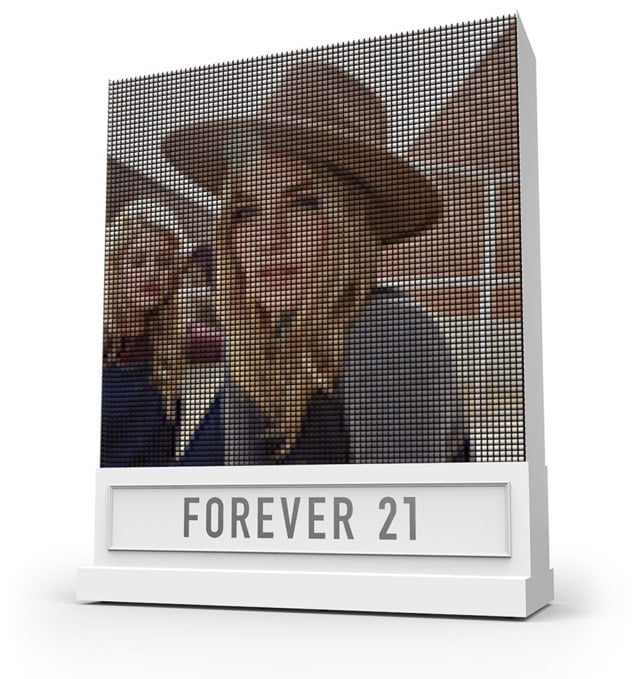
Clothing retailer Forever 21 hired product and prototyping company Breakfast to build them a giant screen made out of spools of thread to “print” people’s Instagram photos. The screen, which Breakfast bills as “one of the most complex machines ever built for a brand”, weighs 2000 pounds, measures 11 ft high, 9 ft wide, and 3 ft deep, and has a resolution of 80x80 spool pixels. Here’s how they made it:
If you want to give it a try, just tag an Instagram photo with #F21ThreadScreen and it’ll print it out for you (watch the live stream). Prior art alert: the first time I remember seeing something like this was Daniel Rozin’s Wooden Mirror (1999) at ITP (video here).
“It’s a Unix system, I know this”
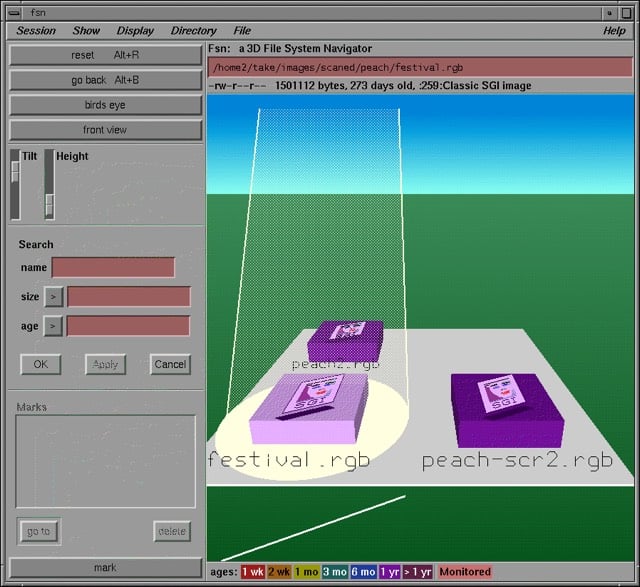
Hold onto your butts, gang… I just found out, via Pixar’s Michael B. Johnson, that the 3D file manager that Lex uses in Jurassic Park — “It’s a Unix system, I know this” — was a real thing. FSN (File System Navigator) was a demo tool for Silicon Graphics’ IRIX operating system that you could download from their web site.
P.S. In that same thread, Johnson shares that his office was the inspiration for Dennis Nedry’s work area.
New York City in motion, 25 years ago
This video was shot in NYC on July 18, 1990, mostly in Times Square and Central Park.
The first 30 seconds of the video (stumbling drunk, trash digger, overheating car) is pretty much a perfect representation of how NYC felt to many at the time. A squeegee man can also been seen at work near the end of the video.
Slow motion lightning
Slow motion video of a South Dakota lightning storm shot at 2000 fps.
I love the little tendrils “sent out” by the clouds before a big strike happens. It’s like nature is searching for the optimal path for the energy to travel and then BAM!
There’s going to be a Minecraft movie. Even if it sucks, every kid in America will see this.
The Good Dinosaur
For the first time since 2005, Pixar didn’t release a movie last year but are doubling up this year with Inside Out and The Good Dinosaur. Here’s the trailer for The Good Dinosaur, which looks like much more of a just-for-kids movie than Inside Out.
The top 10 best running gags on Arrested Development
Still, where did the lighter fluid come from?
Sister is my new mother, Mother.
I’m afraid I just blue myself.
I’m about halfway through season two of Arrested Development again on Netflix and it might be the best show ever on television. I’m not even kidding.
Update: NPR has been obsessively cataloging the show’s running gags here. Holy shit, the extensive foreshadowing of Buster losing his hand! This show is amazing. (via @Nick__Vance)
The Disapproval Matrix
Ann Friedman recently created The Disapproval Matrix to better understand where criticism comes from and how to deal with it.
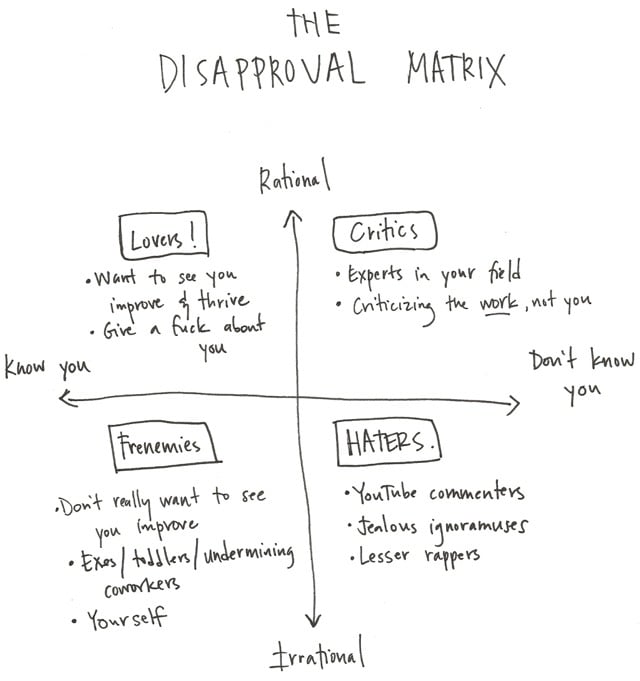
Frenemies: Ooooh, this quadrant is tricky. These people really know how to hurt you, because they know you personally or know your work pretty well. But at the end of the day, their criticism is not actually about your work-it’s about you personally. And they aren’t actually interested in a productive conversation that will result in you becoming better at what you do. They just wanna undermine you. Dishonorable mention goes to The Hater Within, aka the irrational voice inside you that says you suck, which usually falls into this quadrant. Tell all of these fools to sit down and shut up.
See also Friedman’s Hierarchy of Haters.
How to make a Hattori Hanzo sword from Kill Bill
Man at Arms is a YouTube show in which real-life weapons from movies and TV shows are recreated. Recently they made the Bride’s Hattori Hanzo sword from Kill Bill. They started from scratch by building a furnace from before the Edo period (before 1603) to smelt the iron ore.
I know zero about swords, but it looks like these guys really did their homework in making as close to a traditional katana blade as they could. (via devour)
Sea level may rise much faster than previously predicted
James Hansen, NASA’s former top climate scientist, is joined by 16 other leading climate scientists in a paper with some alarming conclusions. The gist is that the glaciers in Antartica and Greenland are melting so much faster than previously predicted that the global sea level will rise more than 10 feet in as little as 50 years, rendering many coastal cities uninhabitable. From Eric Holthaus in Slate:
The study — written by James Hansen, NASA’s former lead climate scientist, and 16 co-authors, many of whom are considered among the top in their fields — concludes that glaciers in Greenland and Antarctica will melt 10 times faster than previous consensus estimates, resulting in sea level rise of at least 10 feet in as little as 50 years. The study, which has not yet been peer reviewed, brings new importance to a feedback loop in the ocean near Antarctica that results in cooler freshwater from melting glaciers forcing warmer, saltier water underneath the ice sheets, speeding up the melting rate. Hansen, who is known for being alarmist and also right, acknowledges that his study implies change far beyond previous consensus estimates. In a conference call with reporters, he said he hoped the new findings would be “substantially more persuasive than anything previously published.” I certainly find them to be.
That’s the thing about nonlinear systems like the Earth’s climate: things happen gradually, then suddenly. This is much more terrifying to me than the Pacific Northwest earthquake. BTW, as a reminder, here’s what NYC and the surrounding area looks like with 10 more feet of water. Goodbye JFK Airport.
Update: The paper is now available online.
Update: In the New Yorker, Elizabeth Kolbert provides a bit more explanation and context about Hansen’s paper.
What the new paper does is look back at a previous relatively warm period, known as the Eemian, or, even less melodically, as Marine Isotope Stage 5e, which took place before the last ice age, about a hundred and twenty thousand years ago. During the Eemian, average global temperatures seem to have been only about one degree Celsius above today’s, but sea levels were several metres higher. The explanation for this, the new paper suggests, is that melt from Antarctica is a non-linear process. Its rate accelerates as fresh water spills off the ice sheet, producing a sort of “lid” that keeps heat locked in the ocean and helps to melt more ice from below. From this, the authors conclude that “rapid sea level rise may begin sooner than is generally assumed,” and also that a temperature increase of two degrees Celsius would put the world well beyond “danger.”
“We conclude that the 2°C global warming ‘guardrail,’ affirmed in the Copenhagen Accord, does not provide safety, as such warming would likely yield sea level rise of several metres along with numerous other severely disruptive consequences for human society and ecosystems,” Hansen and his colleagues wrote.
The Power of Empathy
A nice short animated video on the power of empathy and how it differs from sympathy.
Rarely can a response make something better. What makes something better is connection.
Related: Empathy is a Choice.
Some kinds of people seem generally less likely to feel empathy for others — for instance, powerful people. An experiment conducted by one of us, Michael Inzlicht, along with the researchers Jeremy Hogeveen and Sukhvinder Obhi, found that even people temporarily assigned to high-power roles showed brain activity consistent with lower empathy.
But such experimental manipulations surely cannot change a person’s underlying empathic capacity; something else must be to blame. And other research suggests that the blame lies with a simple change in motivation: People with a higher sense of power exhibit less empathy because they have less incentive to interact with others.
How Buildings Learn
In the mid-90s, Stewart Brand published a fantastic book called How Buildings Learn: What Happens After They’re Built.
Buildings have often been studies whole in space, but never before have they been studied whole in time. How Buildings Learn is a masterful new synthesis that proposes that buildings adapt best when constantly refined and reshaped by their occupants, and that architects can mature from being artists of space to becoming artists of time.
From the connected farmhouses of New England to I.M. Pei’s Media Lab, from “satisficing” to “form follows funding,” from the evolution of bungalows to the invention of Santa Fe Style, from Low Road military surplus buildings to a High Road English classic like Chatsworth-this is a far-ranging survey of unexplored essential territory.
In 1997, Brand and the BBC did a six-part TV series based on the book. Brand has put the series on his YouTube channel; here’s the first part to get you going:
(via open culture)
Understanding Art: Cezanne’s The Large Bathers
Paul Cezanne’s The Large Bathers is the subject of the second video in The Nerdwriter’s series, Understanding Art. (The first was on Jacques-Louis David’s The Death of Socrates.)
The Large Bathers is part of a series of similar paintings by Cezanne. The one used in the video is housed at the Philadelphia Museum of Art:

Other pieces include those from (top to bottom) The National Gallery, The Art Institute of Chicago, and The Barnes Foundation:



That little bird, getting his wings
Former convicts Roby So and Carlos Cervantes pick up inmates on the day they get released from prison to help ease their reentry into society.
By now, Carlos and Roby — officially, A.R.C.’s Ride Home Program — have done about three dozen pickups, either together or individually, waking up long before dawn and driving for hours toward prison towns deep in the desert or up the coast. Then they spend all day with the guy (so far they’ve picked up only men), taking him to eat, buying him some clothes, advising him, swapping stories, dialing his family on their cellphones or astonishing him by magically calling up Facebook pictures of nieces and nephews he’s never met — or just sitting quietly, to let him depressurize. The conversation with those shellshocked total strangers doesn’t always flow, Roby told me. It helps to have a wingman.
“The first day is everything,” Carlos says — a barrage of insignificant-seeming experiences with potentially big consequences. Consider, for example, a friend of his and Roby’s: Julio Acosta, who was paroled in 2013 after 23 years inside. Acosta describes stopping for breakfast near the prison that first morning as if it were a horrifying fever dream: He kept looking around the restaurant for a sniper, as in the chow hall in prison, and couldn’t stop gawking at the metal knives and forks, “like an Aztec looking at Cortez’s helmet,” he says. It wasn’t until he got up from the booth and walked to the men’s room, and a man came out the door and said, “How you doin’?” and Acosta said, “Fine,” that Acosta began to feel, even slightly, like a legitimate part of the environment around him. He’d accomplished something. He’d made a treacherous trip across an International House of Pancakes. He’d peed.
The impending Pacific Northwest earthquake
I know I already posted this in my quick links early last week, but HOLY GOD is this Kathryn Schulz piece about the already-overdue Pacific Northwest earthquake is terrific and terrifying.
Flick your right fingers outward, forcefully, so that your hand flattens back down again. When the next very big earthquake hits, the northwest edge of the continent, from California to Canada and the continental shelf to the Cascades, will drop by as much as six feet and rebound thirty to a hundred feet to the west — losing, within minutes, all the elevation and compression it has gained over centuries. Some of that shift will take place beneath the ocean, displacing a colossal quantity of seawater. (Watch what your fingertips do when you flatten your hand.) The water will surge upward into a huge hill, then promptly collapse. One side will rush west, toward Japan. The other side will rush east, in a seven-hundred-mile liquid wall that will reach the Northwest coast, on average, fifteen minutes after the earthquake begins. By the time the shaking has ceased and the tsunami has receded, the region will be unrecognizable. Kenneth Murphy, who directs FEMA’s Region X, the division responsible for Oregon, Washington, Idaho, and Alaska, says, “Our operating assumption is that everything west of Interstate 5 will be toast.”
Update: Michelle Nijhuis interviewed Schulz about how this piece came about and its impact.
Probably the hardest thing about writing this piece was that from the beginning, this story was two stories for me. It’s the overt, obvious story, which is the story of the Cascadia subduction zone. On its own, that’s an incredible story, one of the best I’ve ever happened to chance upon. But, from the get go, in my mind, it was also really a parable about climate change. And then one level deeper than that, it’s not a parable, but an example about a really deep problem in our human existence, this kind of problem of scale. We are bound by certain temporal and geographic coordinates, and it’s very very hard to see beyond them.
Update: The Pacific Tsunami Warning Center recently posted a revised version of a paper on the link between an “orphan tsunami” that occurred in Japan in 1700 and a massive earthquake in the Pacific Northwest. An accompanying video shows a forecast model animation of the tsunami.
The four shades of introversion
According to a model developed by psychologist Jonathan Cheek and his colleagues, there are actually four types of introversion: social, thinking, anxious, and restrained.
Social: Social introversion is the closest to the commonly held understanding of introversion, in that it’s a preference for socializing with small groups instead of large ones. Or sometimes, it’s a preference for no group at all — solitude is often preferable for those who score high in social introversion. “They prefer to stay home with a book or a computer, or to stick to small gatherings with close friends, as opposed to attending large parties with many strangers,” Cheek said. But it’s different from shyness, in that there’s no anxiety driving the preference for solitude or small groups.
I took the quiz at the bottom of the article and I’m a mix of roughly equal parts social, restrained, and anxious introversion with a dash of thinking.
The worst movie special effects ever
A compilation of some of the world special effects ever to make it to the big screen. Some of these are almost too bad to believe.
(via devour)
Colorblind man sees colors for the first time
…and he FREAKS OUT. I can’t tell if he’s laughing or crying or both. His reaction when he goes outside and sees green grass for the first time: “it’s so pretty!”
The glasses he wears to adjust his color vision are made by EnChroma.
Reviving a 17th century masterpiece
The Met recently cleaned and repaired a 1660 painting by Charles Le Brun called Everhard Jabach and His Family. It took ten months of painstaking work, as this video shows:
Colossal has some before-and-after shots of the painting.
How the Legendary Chuck Jones Became a Great Artist
Tony Zhou and Taylor Ramos are back with another installment of Every Frame a Painting. In this one, they examine the evolution of Looney Tunes animation master Chuck Jones and how his approach and style changed as his career progressed.
I love Looney Tunes. In my mind, Duck Amuck and Rabbit of Seville are some of the finest images put to film. Related: watch Chuck Jones draw Bugs Bunny and the 11 rules of making Road Runner cartoons.
David Chang’s burger manifesto
David Chang has an opinion — several opinions really — about the proper burger.
My ideal burger is bun, cheese, burger. Sometimes bacon. Ketchup on the side, so I can control it. Pickles — yes! Obviously. And the cheese thing has to be very clear: American cheese only. American cheese was invented for the hamburger. People talk about it being processed and artificial and not real cheese — you know what makes it real? When you put it on a hamburger.
But much of his burger manifesto is about what a burger shouldn’t be.
Grass-fed beef does not make burgers, in my opinion. It’s too lean and the fat content is not evenly distributed, so it can get a little mealy. But the dumbest burger in the world is the wagyu bullshit. It’s like 70 percent fat content — it’s disgusting. Would you eat a ground bacon burger? That’s what you’re doing with a wagyu burger. Or the idiots that have “kobe beef wagyu sliders with like a trio of ketchup” on their menu — that drives me insane. The inventor of the kobe beef slider is right next to the inventor of aluminum siding in the Dumbest Thing I’ve Ever Seen Hall of Fame. And you know what’s even more stupid? The fucking customer that buys it because he’s like, Oooohh, kobe, and it’s like $21. God have mercy on their souls.
I love that Chang loves White Castle; I do too1 and make a trip to the one in Hell’s Kitchen about once a month without ever telling another living soul I do so. I agree with most of the rest of his list, 1 but would add one thing: no super-thick burgers, aka most burgers at fancy restaurants. They are too difficult to eat and the massive patty throws everything out of proportion and you end up with a mouthful of burger with very little of anything else. Blech. Balance, people!
I used to go to White Castle all the time with my dad and my sister when I was a kid, back when those sliders were 25¢ apiece. This was the early/mid 80s…there was no chicken sandwich or anything on the menu. I don’t even remember cheese being an option.↩
Especially the “I do not like a burger with a bunch of shit on it”, although one of my current favorite burgers, the Fedora burger at Bar Sardine, breaks that rule with sauce, cucumbers, and shoestring fries. Love that smashed bun. (P.S. My all-time fave burger, besides the ones I make at home, is the ShackBurger.)↩
The stand clear of the closing doors guy
The New Yorker did a short feature on Charlie Pellett, the voice of the NYC subway.
This deep, sometimes vexing voice — which also apologizes for “unavoidable delays” — belongs to a man named Charlie Pellett. A radio anchor for Bloomberg News, Pellett was raised in London but cultivated an American accent by listening to the radio. His work for the M.T.A., which is done on a volunteer basis, is the only non-reporting voice-over work that he’s done.
Self-destructing mosquitos
A company called Oxitec has genetically modified mosquito eggs so that the mosquitos born from them pass along a gene to their offspring that prohibits the mosquitos from reaching sexual maturity and mating. They release the mosquitos into the wild, they mate with the local population of mosquitos, and those born from those matings will die before mating themselves. Voila! Pest control.
Oxitec has conducted trials with its modified mosquito in dengue-ridden regions of Panama, Brazil, Malaysia, and the Cayman Islands. The results show population suppression rates above 90 percent-far greater than the typical 30 percent achieved with insecticides.
The company is currently planning a trial in Florida using this technique to curb an influx of mosquito-borne illness.
The password sharing economy
Netflix and HBO know what you did last summer. And they know you’re still doing it this summer. The sharing of login credentials is so widespread that the big streaming players are losing hundreds of millions a year. So why don’t they stop us? Two reasons: It’s all about growth at this point. And no one has come up with a way to limit credential sharing without hurting the customer experience.
Amazon is a different kind of movie studio. It’s all about getting more people to become Prime members.
You can have the best technology, you can have the best business model, but if the storytelling isn’t amazing, it won’t matter. Nobody will watch. And then you won’t sell more shoes.
Put Harriet Tubman on the $20 bill

Adding her voice to a chorus of others, Amy Davidson makes a great case for putting Harriet Tubman on the US $20 bill and kicking Andrew Jackson to the curb.
On September 17, 1849, Araminta, who now called herself Harriet, ran away to freedom, along with two of her brothers. Their owner, Eliza Brodess-Pattison’s granddaughter-in-law-had been making moves to sell them, and the fear was that the family would be broken up. Brodess put an ad in the local newspaper, offering a hundred-dollar reward each for “Minty,” Harry, and Ben. (The only extant copy of the ad was found in 2003, in a dumpster.) Almost immediately, Tubman began making trips back to Maryland, organizing the escapes of relatives, friends, and scores of other slaves, often just ahead of armed men pursuing them. On one trip, she discovered that her husband, John Tubman, who was free himself, was living with another woman; he had no interest in going north. He is a man who seems not to have known Tubman’s worth.
When I was a kid, I read a lot of biographies1 on people like Ben Franklin, Thomas Edison, Abraham Lincoln, and the Wright brothers. My favorite, which I read at least three times, was Ann Petry’s Harriet Tubman: Conductor on the Underground Railroad. Tubman is one of history’s greatest badasses. Put her on the damn bill.
Our local public library had a series of biographies for kids…I wish I could remember what these books were. I did a little research just now but nothing came up. I remember them being small (hardcovers but the size of paperbacks), no dust jackets, and plainly titled (e.g. “Abraham Lincoln”). There were around 50 titles and must have been 20-30 years old when I read them in the early 80s. I devoured them as a kid and would love to pass them along to my kids.↩
Current footballers on olde timey trading cards
If you want to see what Leo Messi, Cristiano Ronaldo, and Neymar might have looked like if they played in the 1950s/60s, Paladar Negro photoshopped some Barcelona & Real Madrid players onto old timey trading cards.

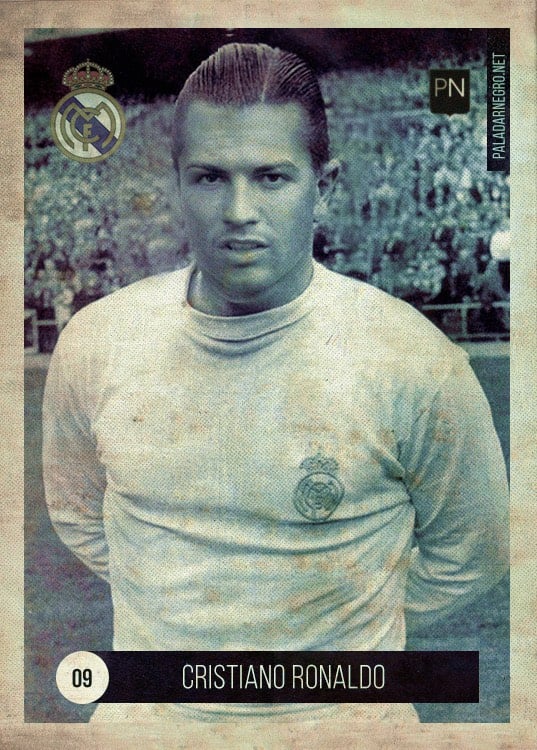
They previously did a similar project with Argentinian players…this one of Angel Di Maria is amazing:
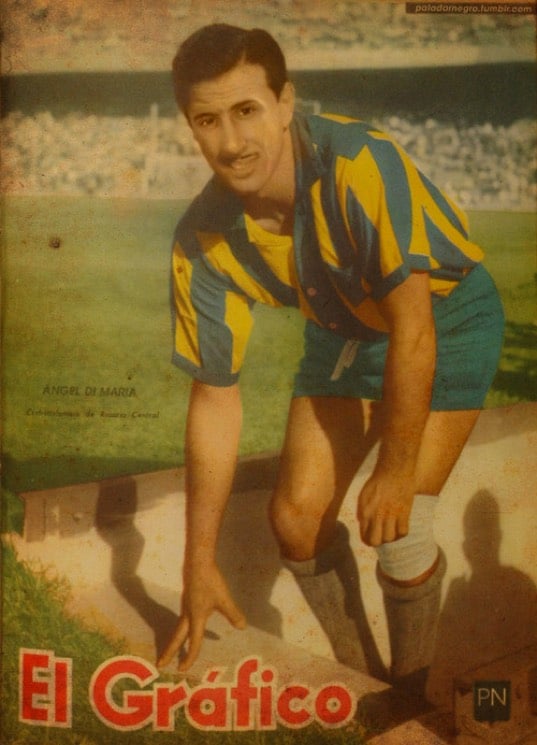
(via @craigpatik)
Amazon Prime Day deals?
Today is Amazon Prime Day, a totally manufactured holiday invented to sell you stuff you don’t need…no, not like those other totally manufactured holidays — Mother’s Day, Father’s Day, Christmas — invented to sell you stuff you don’t need. Ok anyway, the deals are out but people are yawning about them a bit. But there are some nice bargains to be had, if you’re in the market (and are an Amazon Prime member): Kindle (for $49) (all gone!), Herschel backpacks, $10 credit for buying Amazon gift card multipacks, and get a free $30 gift card if you order $75 or more in Amazon Home Services. I’m eyeing that Kindle a little — my son is agitating for a hand-me-down of my current one — but wish it were a Paperwhite instead. Is the Paperwhite really worth the extra $70?
Update: Oh and coincidentally, the 55-gallon drum of lube is on sale today too for $1360, 46% off the usual price. There’s only three left though, so hurry!
Peggy Olsen x Drake
Clips of Peggy Olsen from Mad Men set to Drake’s Started From the Bottom.
(via av club)
Winners of the 2014 50 Books | 50 Covers competition
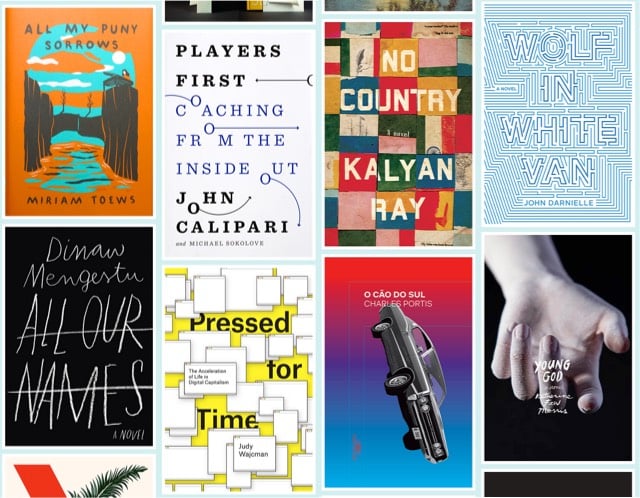
Design Observer and the AIGA have announced the winners of their 50 Books | 50 Covers competition to find the best designed books and book covers published last year. The books are here and the covers are here.

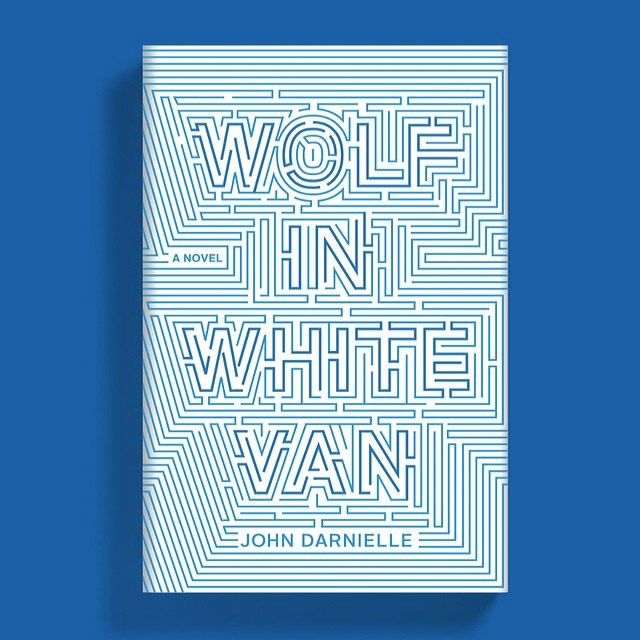
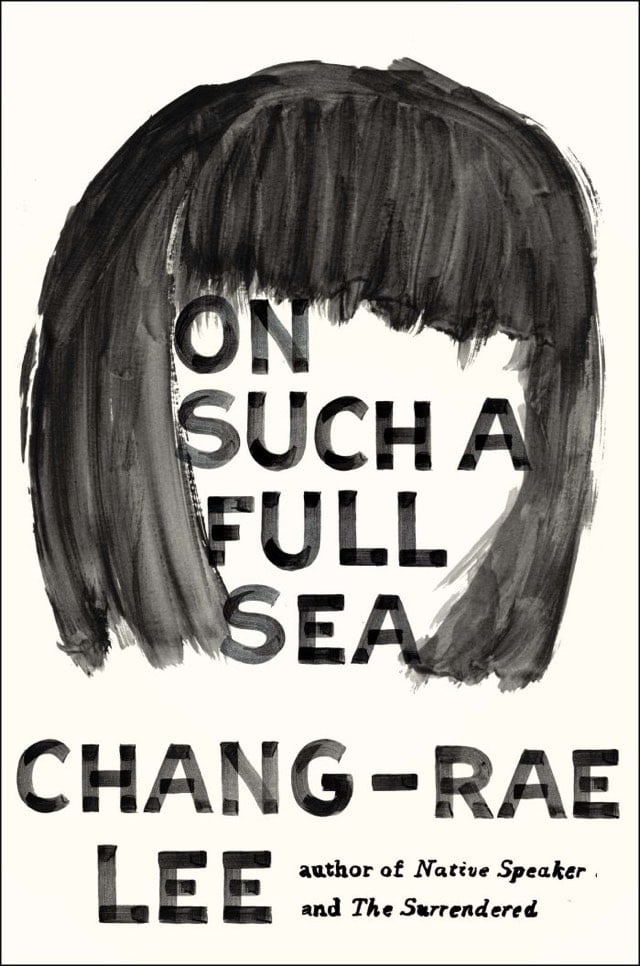
They’re publishing a book and putting on an exhibition in New Orleans of the winners and need your help on Kickstarter to make it happen.
Dr. Strangelove is streaming for free on Amazon for Prime members. If you haven’t seen it, now’s your chance.
Saving the open web
In 2008, Hossein Derakhshan was sentenced to 20 years in jail in Iran for blogging and championing the open web. Released and pardoned late last year, Derakhshan is now wondering why the web he went to jail for is dying and why no one is stopping it. Just as things changed in the real world while he was imprisoned:
Around me, I noticed a very different Tehran from the one I’d been used to. An influx of new, shamelessly luxurious condos had replaced the charming little houses I was familiar with. New roads, new highways, hordes of invasive SUVs. Large billboards with advertisements for Swiss-made watches and Korean flat screen TVs. Women in colorful scarves and manteaus, men with dyed hair and beards, and hundreds of charming cafes with hip western music and female staff. They were the kinds of changes that creep up on people; the kind you only really notice once normal life gets taken away from you.
…so too did the web:
The hyperlink was my currency six years ago. Stemming from the idea of the hypertext, the hyperlink provided a diversity and decentralisation that the real world lacked. The hyperlink represented the open, interconnected spirit of the world wide web — a vision that started with its inventor, Tim Berners-Lee. The hyperlink was a way to abandon centralization — all the links, lines and hierarchies - and replace them with something more distributed, a system of nodes and networks.
Blogs gave form to that spirit of decentralization: They were windows into lives you’d rarely know much about; bridges that connected different lives to each other and thereby changed them. Blogs were cafes where people exchanged diverse ideas on any and every topic you could possibly be interested in. They were Tehran’s taxicabs writ large.
Since I got out of jail, though, I’ve realized how much the hyperlink has been devalued, almost made obsolete.
(via @anildash)
A musical journey away from Earth
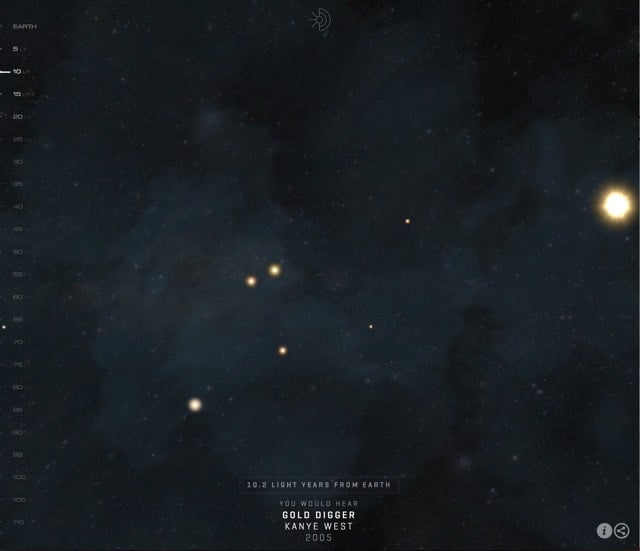
Taking inspiration from the opening sequence of Contact, lightyear.fm is a musical journey away from the Earth. As you get farther out (say, 10 light years away, just past star Ross 154 in the constellation of Sagittarius), you hear music that was broadcast on the radio at that time (Gold Digger by Kanye West).
Radio broadcasts leave Earth at the speed of light. Scroll away from Earth and hear how far the biggest hits of the past have travelled. The farther away you get, the longer the waves take to travel there — and the older the music you’ll hear.
This is the coolest.
This is the best-ever photo of Pluto. Tomorrow’s will be MUCH better.
This morning, the New Horizons probe zinged safely1 past Pluto. Before it did, it transmitted the best photo we’ve seen of Pluto so far…the last one we’ll get before we get the really good stuff. Look at this:

The probe’s “I’m OK!” message will reach Earth around 9pm ET tonight and we’ll start seeing photos from the flyby Wednesday afternoon…there’s a NASA press conference scheduled for 3pm ET on July 15. So exciting!
Update: The photo above is also the best full-disk image of Pluto that we will get…the rest will be close-ups and such. So that’s the official Pluto portrait from now on, folks.
Well, hopefully. The probe is due to transmit a “I’m OK!” message back to Earth later today (at around 9pm ET). *fingers crossed*↩
New subatomic particle: the pentaquark!
CERN’s LHC (Large Hadron Collider) has discovered a new subatomic particle, the pentaquark.
“The pentaquark is not just any new particle,” said LHCb spokesperson Guy Wilkinson. “It represents a way to aggregate quarks, namely the fundamental constituents of ordinary protons and neutrons, in a pattern that has never been observed before in over fifty years of experimental searches. Studying its properties may allow us to understand better how ordinary matter, the protons and neutrons from which we’re all made, is constituted.”
Here’s the paper, with more than 680 authors. Between New Horizons zipping past Pluto earlier today (look at this pic!) and this, what a day for science.
What it’s like to be face blind
Prosopagnosia is a disorder where you’re unable to recognize faces. Neurologist Oliver Sacks and artist Chuck Close are both face-blind. This is a really interesting interview with a woman who suffers from prosopagnosia so completely that she cannot recognize her own daughter or even herself (sometimes).
The researchers concluded that I’m profoundly face-blind. One thing I find very difficult to get across is that it’s not as if I can’t recognize anybody at all — it’s that it can take me up to five minutes before I can figure out who they are. I have to wait for the signs. The other thing I have discovered is that there is a specific expression people have when they see somebody they know.
I call it the “I know you face” — it’s sort of a surprised micro expression. I’m convinced that it’s completely involuntary. It looks a little like surprise. The eyebrows go up, and usually the mouth opens like they’re about to say something. When I see it, I say hello, and then when I start interacting with them, I’ll remember who they are. That’s just one of a whole set of observational skills I’ve developed. Another is when I’m meeting somebody in public, I’ll arrive early so they’ll approach me.
I’m always looking for visual hooks. My daughter has a particular thing she does with her mouth. If there’s several people who could be her, I look for the mouth thing. If she’s nervous, or she’s irritated, one side of her mouth goes up. She’s done it since she was a baby. She doesn’t like having her photograph taken, so when I look at a group photo, I look for the kid with the smirk and I know it’s my daughter.
But her face-blindness is sometimes an advantage:
I’m also a very good listener because the tone of voice and body language are what I always pay attention to. I’m good at calming people down, because I can tell when they’re starting to freak out.
And she’s also less quick to notice things like race or gender:
When I worked at a homeless shelter, I was often praised for the way I interacted with my African-American clients. I couldn’t figure out what I was doing differently from the other white workers, but I was allowed into their circle and they bonded with me. When we lived in Louisiana, I was always being asked by African-American women if my husband was black.
When I was tested at Dartmouth, I scored low on unconscious racism. Apparently babies show a preference for their own race at about nine months because that’s when they start being able to recognize faces. My head doesn’t do this.
(via mr)
Every item in grandpa’s tool shed
Lee John Phillips is attempting to draw every single item in his late grandfather’s tool shed.
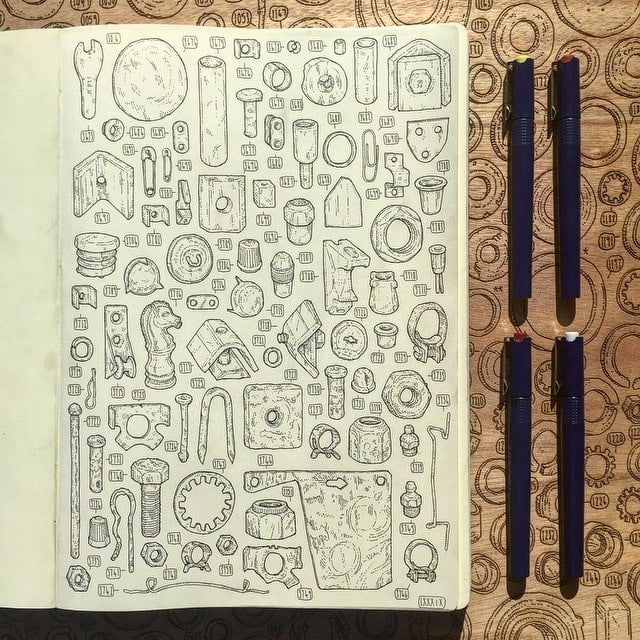
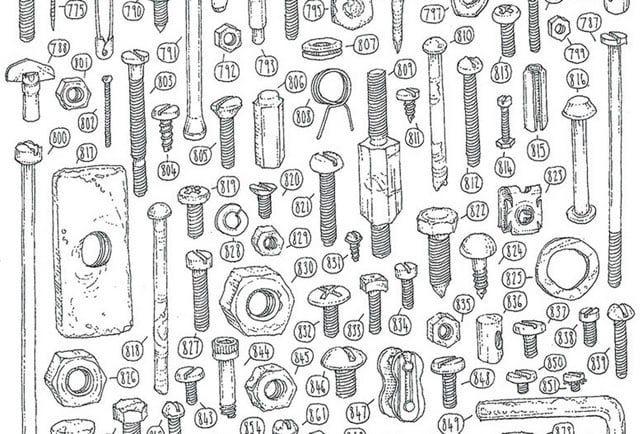

You can follow his progress on Instagram.
F1 champ quickly goes from worst to first at go-kart track
Formula 1 driver Fernando Alonso recently tried his luck at a go-kart track in the UK. Starting from last position, he worked his way up to first in less than three laps.
That’s neat, but I’m more interested in the person in the lead kart, who presumably hasn’t won two F1 championships and hasn’t been racing karts since age 3, who holds Alonso off for an entire lap before being passed. Nice work, mate! (via digg)
What’s the best sunscreen?
I went to the beach yesterday and it was the best thing ever. But today is slightly less great because my back is sunburned. I stupidly didn’t reapply after swimming. I need to do better. Shannon Palus of The Sweethome recently surveyed the sunscreen landscape and picked the best sunscreen: NO-AD Sport SPF 50.
At 56 cents per ounce, the NO-AD sunscreens cost half as much as their closest competitors. We liked this one best because it has no added fragrance, is water resistant, and consistently placed among the top three during blind application tests by our six-person panel.
But the main takeaway from the article is that people aren’t using enough sunscreen. We don’t apply it liberally enough nor do we reapply as often as you should.
Related: how to identify and avoid rip currents at the beach so you don’t die.
Update: On the other hand, EWG’s Guide to Sunscreens rates the NO-AD Sport very poorly, mainly because of chemicals that “pose a HIGH health concern”. They recommend buying something like Coola Classic Sport SPF 50 or Coppertone Sport Sunscreen Lotion, SPF 30 instead. The Sweethome review addresses such chemicals, saying that protection from the Sun is much more important:
If you are using a sunscreen that is paraben- or oxybenzone-free because you’re concerned about these chemicals, stop letting those be a factor in your decision-making. As we’ll explain in our ingredients section, there’s far too much alarm out there about the supposed harm sunscreens will do to you if you apply it to your skin. We will work through all the reasons why you shouldn’t be worried below. You should be much more worried about the sun exposure that can result from poor and infrequent application.
A couple of years ago, I bought a sunscreen listed on EWG’s guide. It was expensive, gross-feeling, and difficult to use…the bottle actually ended up breaking with about 1/3 of the contents still trapped inside. The Sweethome review hits on something that seems superficial but is really important: buying sunscreen that works, is affordable (so you will actually reapply), and that you’ll actually use is essential. Buying a more expensive sunscreen with fewer potentially harmful chemicals that feels gross, smells weird, and doesn’t make you want to reapply is going to result in skin damage that will far exceed any potential damage done by chemicals. (thx, brian & tom)
Trailer for the Sherlock Christmas special
With the pace of the excellent Sherlock series slowing down a bit because of scheduling (Cumberbatch, Freeman, Moffat, and Gatiss are increasingly busy), they still somehow found time to shoot a Christmas special that will air in December 2015. Here’s a short teaser scene:
Update: A longer trailer. Makes it look a bit darker than the regular show, which I’m not sure is a good thing.
In which we discover that Michael Bloomberg didn’t read the What Is Code? issue of his own magazine
Star Wars: The Force Awakens, Comic-Con 2015 Reel
They showed this 3 minute 30 second behind the scenes video of Star Wars: The Force Awakens at Comic-Con yesterday.
Fans at San Diego Comic-Con’s Hall H were treated to a special look behind the scenes of Star Wars:The Force Awakens by director J.J. Abrams, producer and Lucasfilm President Kathleen Kennedy and writer Lawrence Kasdan. The filmmakers were joined on stage by cast members Daisy Ridley, John Boyega, Adam Driver, Oscar Isaac, Domhnall Gleeson, Gwendoline Christie, Mark Hamill, Carrie Fisher and Harrison Ford to the surprise and delight of fans.
At the end of the Hall H presentation, the entire Hall H audience of more than 6,000 fans were all invited to continue the celebration and join cast and filmmakers at a surprise Star Wars Fan Concert. The San Diego Symphony performed the classic Star Wars music from John Williams at the Embarcadero Marina Park South.
I have zero interest in Comic-Con, but that would have been pretty cool to see.
The science of Pixar’s Inside Out
Psychologists Dacher Keltner and Paul Ekman served as scientific consultants during the production of Pixar’s Inside Out. Keltner studies the origins of human emotion and Ekman pioneered research of microexpressions. In this NY Times piece, they discuss the science behind the movie.
Those quibbles aside, however, the movie’s portrayal of sadness successfully dramatizes two central insights from the science of emotion.
First, emotions organize — rather than disrupt — rational thinking. Traditionally, in the history of Western thought, the prevailing view has been that emotions are enemies of rationality and disruptive of cooperative social relations.
…
Second, emotions organize — rather than disrupt — our social lives. Studies have found, for example, that emotions structure (not just color) such disparate social interactions as attachment between parents and children, sibling conflicts, flirtations between young courters and negotiations between rivals.
I’ve thought about Inside Out every day since I saw it. Pixar clearly did their homework on the emotional stuff and it paid off.
Eye in the sky: a “pre-crime” surveillance system
A company called Persistent Surveillance Systems has built a “pre-crime” surveillance system. The idea is that you fly a cluster of video cameras over an area that can be the size of a small city — using an airplane or even a drone — and you transmit the day’s activities of the entire city to a computer on the ground. When a crime is committed, a system analyst can scrub the video forward and backward in time to find out where the perpetrator came from and where they go after. Ideally, this happens minutes after the crime is committed so the perps can be apprehended. Radiolab recently had a great piece on this technology and its privacy implications.
The system also has other uses — like tracking traffic patterns — but yaaawn. In one of the trials of the technology described in the show, the surveillance video of a hit on a police officer in Juarez, Mexico by members of a drug cartel showed them driving back to what turned out to be the cartel’s headquarters. Another trial, in Dayton, OH, resulted in the capture of a burglar only a few blocks from where the crime was committed. Radiolab called this technology a superpower, like Batman hacking into all of the world’s cellphones or Superman hovering above the Earth listening to everyone’s conversations. Less imaginary comparisons would be to London’s network of CCTV cameras or the NSA’s recording of a large amount of the world’s electronic communications. Fascinating and terrifying all at once.
What we’ll see from New Horizons’ flyby of Pluto
As the New Horizons probe nears Pluto, I’ve been reading a bit more about how it’s going to work and what sort of photos we’re going to get. Emily Lakdawalla has a comprehensive post about what to expect when you’re expecting a flyby of Pluto. The post contains an image of approximations of the photos New Horizon will take, using Voyager images of Jovian and Saturnian moons as stand-ins. The highest resolution photo of Pluto will be 0.4 km/pixel…it’ll have this approximate level of detail:

Which is pretty amazing and exciting considering that before the mission started this was our best view of Pluto:

NASA’s Eyes app lets you see a simulation of the probe as it approaches Pluto, but if you don’t want to download anything, you can watch this video of the flyby instead:
I had no idea the probe spun around so much as it grabs photos & scans and then beams them back to Earth. And the flyby is so fast! New Horizons is currently moving at 32,500 mph relative to the Sun…it’s travelling just over 9 miles every second. (via @Tim_Meyer_ & @badastronomer)
In search of the longest NYC subway ride

The WNYC Data News Team is looking for the longest possible NYC subway ride. The MTA says the longest direct trip is 38 miles, but WNYC found one that’s 148 miles, requiring 45 transfers. They’re running a little competition to see who can find a longer ride…check the rules for more details (short version: you can repeat stations but not track segments). This is basically a variant of the travelling salesman problem, yes? Anyone care to take a crack at it? (via @ryandawidjan)
The Art of the Opening Shot
The opening scenes from dozens of movies, including 2001, There Will Be Blood, Lost in Translation, Seven Samurai, and Star Wars.
(via devour)
How Google’s self-driving car sees the road
Chris Umson is the Director of Self-Driving Cars at Google[x] and in March, he gave a talk at TED about the company’s self-driving cars. The second half of the presentation is fascinating; Umson shows more than a dozen different traffic scenarios and how the car sees and reacts to each one.
It will be interesting to see how roads, cars, and our behavior will change when self-driving cars hit the streets. Right now, street markings, signage, and automobiles are designed for how human drivers see the world. Computers see the road quite differently, and if Google’s take on the self-driving car becomes popular, it would be wise to adopt different standards to help them navigate more smoothly. Maintaining painted lines might be more important, along with eliminating superfluous signage close to the roadway. Maybe human-driven cars would be required to display a special marking alerting self-driving cars to potential hazards.1 Positioning of headlights and taillights might become more standard.
Human drivers, cyclists, and pedestrians will necessarily adapt to self-driving cars as well. Some will take advantage of the cars’ politeness. But mostly I suspect that learning to interact with self-driving cars will require a different approach, just as people talk to computers differently than they do to other humans — think of how you formulate a successful search query, speak to Siri, or, more to the point, manipulate a Wii remote so the sensor dingus on top of your TV can interpret what you’re doing.
Although if the car is smart enough to parse the arm motions of a police officer directing traffic, it can probably pick out the relatively inconsistent movement of a human-driven car in a second or two.↩
Highlighting Hollywood’s race problem
On his YouTube channel, Dylan Marron is cutting down films to only include dialogue spoken by persons of color. Under those conditions, Moonrise Kingdom is 10 seconds long. Her is about 40 seconds. Noah is 0 seconds.
(via @riondotnu)
Remaster of The Iron Giant coming out in theaters
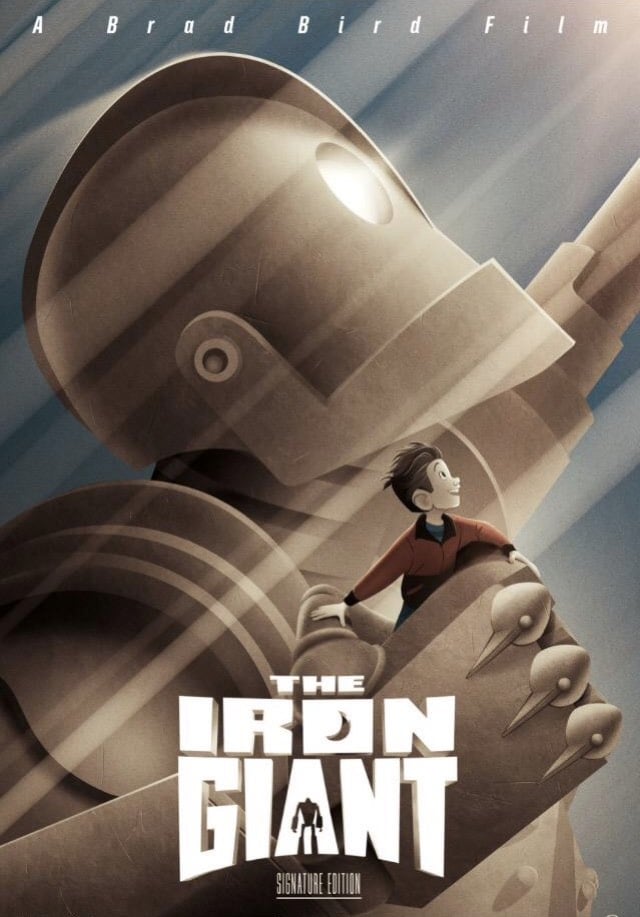
The Iron Giant has been remastered and burnished with a pair of extra scenes for a re-release in US theaters scheduled for the end of September.
Warner Bros. and Fathom Events are teaming up to bring The Iron Giant back to life. The beloved 1999 animated film is being remastered and augmented with new footage, and it’s coming to select American theatres as what the studio’s calling the “Signature Edition” on September 30th. There’ll also be an encore presentation in select theatres a few days later on October 4th.
The movie earned a respectable $23 million at the box office and critical acclaim, but failed to recoup its $70 million production budget. After reading a bunch of positive reviews, including one from my cinematic divining rod Roger Ebert, I was one of the brave few souls to see The Iron Giant in the theater. Hope to catch it again in September. (via @anildash)
The Dissolve dissolves
Bummer, film site The Dissolve has shut down. They burned bright for a short time.
For the past two years-well, two years this Friday — it’s been our pleasure to put up this site, a site founded on and driven by a love for movies, alongside a company with passion and talent for creating thoughtful, important work. Sadly, because of the various challenges inherent in launching a freestanding website in a crowded publishing environment, financial and otherwise, today is the last day we will be doing that. We’ve had this opportunity thanks to Pitchfork, which has been incredibly supportive of our vision. We couldn’t have asked for a better partner.
I’ve linked to a few of their things over the past few months, and the quality was always high. Tony Zhou has collected a few of his favorite pieces from the site.
Parenthood is indescribable
Mario Koran writes about how tough it can be to be a parent (particularly a single parent) and the impossibility of describing parenthood to someone without kids. This all rings true to me, especially this bit:
I also learned that being a dad means living in constant fear. Due to dumb, random chance, or a second’s negligence, my entire world could implode at any moment. She could be electrocuted, shot, run-over, kidnapped or poisoned. She could get leukemia. It’s all there, just waiting to happen. Each week, the fear seems to grow.
During the day, I keep these emotions contained in wire mesh. I can see the feelings. I know they’re there, behind the wire. But I ignore them. I focus on work. At night, that wire mesh falls away. It’s just my wife and Lucia and me, singing Twinkle Twinkle or ABCs — or Twinkle Twinkle to the tune of ABCs. Some nights, after we tick off the lights and everything’s quiet, I feel so much I suddenly realize I’m crying.
Elsewhere, danah boyd on “the irrational cloud of fear”. Even Steve Jobs, not the best parent in the world, said that having kids is like having “your heart running around outside your body”. Not every parent feels this way, but if you are prone to anxiety, that pretty much covers it.
This is the best-ever photo of Pluto. Tomorrow’s will be better.
Pluto is so far away that we haven’t even been able to get a good look at it, not even with the crazy-powerful Hubble telescope. But with NASA’s New Horizons mission closing in on our solar system’ ninth planet,1 we are getting a better and better view of Pluto every day.1 Here’s the latest, from just a few hours ago:

New Horizons will reach its closest approach to Pluto in just under 6 days, on July 14. The probe will pass within 7,800 miles of the surface…I can’t wait to find out what that day’s photos look like.
Update: You don’t even need to wait until tomorrow for that better image…here’s one that NASA released just a short while ago. Tune in tomorrow for an even better view.

Oh yeah, I’m not letting this one go.↩
New Horizons’ imaging capability of Pluto surpassed Hubble’s on May 15, 2015. So every picture since then has been better than what we’ve had previously.↩
This Shovel Falling Sounds Exactly Like Smells Like Teen Spirit
♬ With the shovel out, the ice’s less dangerous / Drop the shovel, entertain us / I feel stupid and contagious / Drop the shovel, entertain us ♬
Magisterial. I love the internet. This is even better than the door that sounds like Miles Davis. (via @slowernet)
Update: Oh, and this nightstand door sounds like Chewbacca. (via @steveportigal)
What’s the best medium for a storyteller in 2015? Films? TV? Games? Comics?
A Woman in Uniform
An NYPD officer anonymously shares what it’s like to be a cop in NYC.
I’m walking in Boerum Hill on one of the first really good days of summer. It’s been a long week but I’m feeling good in a flowing sundress and sandals, relieved to be freed from what I’ve begun to think of as my blue polyester prison. I look up and realize with amusement that I’m walking by an actual prison, or, to be precise, a jail: Brooklyn Central Booking.
The doors to the courtroom lobby open and a man emerges, pausing to survey the street. He’s a little scruffy but then the newly arraigned usually are — there aren’t many opportunities to freshen up in the holding cells. He has an open, pleasant face, and the recognition on my part is immediate. My heart sinks as I see him cross the street and make a beeline for me.
“Miss? Miss?” He doesn’t sound particularly confrontational and I give him my best blank smile, hoping he has some kind of mundane procedural question.
“I don’t mean to like bother you or anything, but if you’re not busy, and a beautiful lady such as yourself is probably busy, but if you’re not busy I’d love to buy you a cup of coffee.”
Now I have to grin. This is my new favorite person in the world. What chutzpah! I’m so delighted by this guy that I almost chuck him on the shoulder. Then it hits me. He doesn’t recognize me, at all. He has no idea that I’m the person who arrested him two nights before.
(via @choire, who called it “BY FAR the most interesting thing i read all week”)
Young Han Solo movie announced
Disney is proceeding at full steam in delivering more Star Wars to your eyeballs. Today they announced that Christopher Miller and Phil Lord, the duo behind The Lego Movie, will direct a movie about a young Han Solo.
The screenplay is written by Lawrence Kasdan and Jon Kasdan. The story focuses on how young Han Solo became the smuggler, thief, and scoundrel whom Luke Skywalker and Obi-Wan Kenobi first encountered in the cantina at Mos Eisley.
Release date is May 2018. As Princess Leia once said, “Disney, I hope you know what you’re doing.”
Screen addiction (or why Grandma’s sad)
Screen Addiction Is Taking a Toll on Children, from Jane Brody in the NY Times:
Parents, grateful for ways to calm disruptive children and keep them from interrupting their own screen activities, seem to be unaware of the potential harm from so much time spent in the virtual world.
In reply, John Hermann writing at The Awl:
The grandparent who is persuaded that screens are not destroying human interaction, but are instead new tools for enabling fresh and flawed and modes of human interaction, is left facing a grimmer reality. Your grandchildren don’t look up from their phones because the experiences and friendships they enjoy there seem more interesting than what’s in front of them (you). Those experiences, from the outside, seem insultingly lame: text notifications, Emoji, selfies of other bratty little kids you’ve never met. But they’re urgent and real. What’s different is that they’re also right here, always, even when you thought you had an attentional claim. The moments of social captivity that gave parents power, or that gave grandparents precious access, are now compromised. The TV doesn’t turn off. The friends never go home. The grandkids can do the things they really want to be doing whenever they want, even while they’re sitting five feet away from grandma, alone, in a moving soundproof pod.
As a writer for screens, someone who spends a tremendous amount of time each day staring at screens, and an involved parent of two grade-schoolers, this is precisely where my professional and personal lives meet, so I’ve done a bit of thinking about this recently. Here’s what I’ve come up with and am attempting to actually believe:
People on smartphones are not anti-social. They’re super-social. Phones allow people to be with the people they love the most all the time, which is the way humans probably used to be, until technology allowed for greater freedom of movement around the globe. People spending time on their phones in the presence of others aren’t necessarily rude because rudeness is a social contract about appropriate behavior and, as Hermann points out, social norms can vary widely between age groups. Playing Minecraft all day isn’t necessarily a waste of time. The real world and the virtual world each have their own strengths and weaknesses, so it’s wise to spend time in both.
Colorado’s success in curbing teen pregnancies
Colorado has spent the last six years conducting a real life test to see if they could reduce the number of unwanted pregnancies and abortions. As the NYT’s Sabrina Tavernise explains, the results were stunning.
If we want to reduce poverty, one of the simplest, fastest and cheapest things we could do would be to make sure that as few people as possible become parents before they actually want to.
Fibonacci sequence hidden in ordinary division problem
If you divide 1 by 999,999,999,999,999,999,999,998,999,999,999,999,999,999,999,999 (that’s 999 quattuordecillion btw), the Fibonacci sequence neatly pops out. MATH FTW!

At the end of Carl Sagan’s Contact (spoilers!), the aliens give Ellie a hint about something hidden deep in the digits of π. After a long search, a circle made from a sequence of 1s and 0s is found, providing evidence that intelligence was built into the fabric of the Universe. I don’t know if this Fibonacci division thing is on quite the same level, but it might bake your noodle if you think about it too hard. (via @stevenstrogatz)
Update: From svat at Hacker News, an explanation of the magic behind the math.
It’s actually easier to understand if you work backwards and arrive at the expression yourself, by asking yourself: “If I wanted the number that starts like 0.0…000 0…001 0…001 0…002 0…003 0…005 0…008 … (with each block being 24 digits long), how would I express that number?”
(thx, taylor)
I can’t believe it’s not newspaper
Randall Rosenthal makes amazingly realistic wooden sculptures of everyday objects like newspapers, legal pads, baseball cards, and kitchen scenes. He carves each of his sculptures out of a single block of wood. So, this is carved entirely out of wood:

And so is this:

And this too:
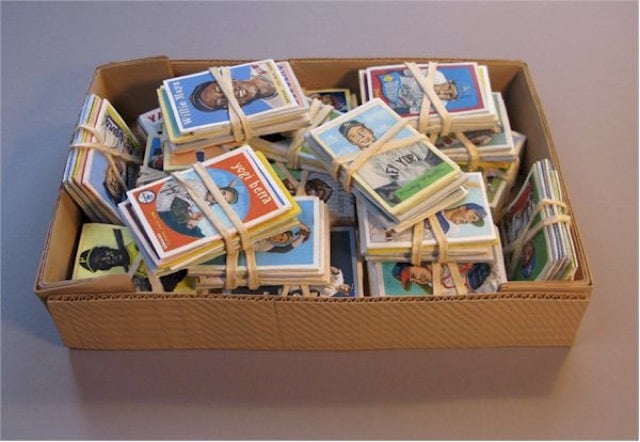
And here’s a look at that last sculpture in progress:

(via @pieratt)
Books in the films of Wes Anderson
Books loom large in Wes Anderson’s movies. Several of his films open with opening books and Fantastic Mr. Fox is based on an actual book. Here’s a nicely edited selection of bookish moments from Anderson’s films.
In the work of Wes Anderson, books and art in general have a strong connection with memory. The Royal Tenenbaums (2001) begins with a homonymous book, as does Fantastic Mr. Fox (2009). The Grand Budapest Hotel (2014) begins and ends with a book. Moonrise Kingdom (2012) ends with a painting of a place which no longer exists. These movies have a clear message: books preserve stories, for they exist within them and live on through them.
A 1968 computer art contest

From the August 1968 issue of Computers and Automation magazine, the results of their Sixth Annual Computer Art Contest (flip to page 8).


It’s also worth paging through the rest of the magazine just for the ads.
Update: Looks like The Verge saw this post and did a followup on the history of the Computer Art Contest.
In any given issue, Computers and Automation devoted equal time to the latest methods of database storage and grand questions about the future of their “great instrument,” but the Computer Art Contest was soon a regular event. A look back through old issues of the journal (available at Internet Archive) shows how the fledgling discipline of computer art rapidly evolved. At the time, computers were specialized tools, most commonly used by individuals working in research labs, academia, or the military — and this heritage shows. Both the first and second prizes for the inaugural 1963 competition went to designs generated at the same military lab.
Three reasons the American Revolution was a mistake (1. Slavery would have been abolished earlier…)
What was the Venus de Milo doing with her arms?
The Venus de Milo’s arms are lost to history but that hasn’t stopped historians and scholars wondering what exactly she was doing with them when the statue was carved. In order to test out a theory that Venus was spinning thread, Virginia Postrel hired designer and artist Cosmo Wenman to construct a 3D model of Venus de Milo.

A guide to Don DeLillo’s books
This list ranking Don DeLillo’s novels into categories ranging from “Classic” to “Avoid” from 2007 excludes his two most recent novels, but if you have little exposure to the author, it’s a good place to start.
White Noise. DeLillo’s breakthrough success, arguably still his quintessential masterpiece, and the funniest and most sustained example of his talent. Jack Gladney, professor of Hitler Studies, struggles with information overload, simulated disasters, an “airborne toxic event,” the most photographed barn in America, and a drug that neutralizes the fear of death. If you’re going to like DeLillo, this is the book that will make it happen.
Confession: aside from attempting to tackle Underworld1 more than 10 years ago, I have not read any DeLillo. I should probably fix that? (via @davidgrann)
I bought my copy of Underworld at a San Francisco used book store at the same time I bought Infinite Jest. Like I said, Underworld didn’t do it for me, but reading IJ became an odd sort of turning point in my life.↩
Saul Bass’ best film title design work
Saul Bass designed the opening sequences for dozens of films, including North by Northwest, Psycho, West Side Story, and Goodfellas. Here’s a look at some of his best work:
(via art of the title)
How people respond to life-changing inventions
Near the end of a piece by Morgan Housel called Innovation Isn’t Dead, appears “the typical path of how people respond to life-changing inventions”:
1. I’ve never heard of it.
2. I’ve heard of it but don’t understand it.
3. I understand it, but I don’t see how it’s useful.
4. I see how it could be fun for rich people, but not me.
5. I use it, but it’s just a toy.
6. It’s becoming more useful for me.
7. I use it all the time.
8. I could not imagine life without it.
9. Seriously, people lived without it?
That’s about right. I can only recall a couple of instances where I’ve skipped from step 1 to step 8 or 9: when I first used the Web1 and when Jobs introduced the iPhone at MacWorld. Everything else — Google, HD TV, Twitter, personal computers, streaming music services, wifi, laptops, Instagram, mobile phones — went through most of the 9 phases. (via @cdixon)
Not the Internet, the Web. I used the Internet before I used the Web (Usenet, FTP, and Gopher mostly) and I never got the “OMG this is going to change everything” vibe I got after using the Web for five minutes.↩
How Peter Luger chooses their beef
Eater’s Nick Solares accompanies the proprietor of Peter Luger Steakhouse to one of the few remaining butchers in the Meatpacking District1 to see how she selects meat for the restaurant.
You know, that place with all the fancy shops, night clubs, and garbage people.↩
Colbert hosting cable access shows in his spare time
Stephen Colbert recently guest hosted Only in Monroe, a public access cable TV talk show based in Monroe, Michigan. His guest? Michigander Marshall Mathers.1
God, he is so good. I might actually have to watch the Late Show this fall. (thx, michelle)
Do I need the “aka Eminem” here?↩
Is the fish kick the fastest swimming stroke yet? http://t.co/F2RPo7Q8Sl
Compasses don’t work on Mars, so how do you navigate?
Unlike the Earth, Mars and the Moon don’t have strong directional magnetic fields, which means traditional compasses don’t work. So how did the Apollo rovers and current Mars rovers navigate their way around? By using manually set directional gyroscope and wheel odometers.
While current un-crewed rovers don’t have to return to the comfort of a lunar module, some aspects of the Apollo systems live on in their design. Four U.S. Martian rovers have used wheel odometers that account for slippage to calculate distance traveled. They’ve also employed gyroscopes (in the form of an inertial measurement units) to determine heading and pitch/roll information.
One of the fun things about reading The Martian is you get to learn a little bit about this sort of thing. Here’s a passage about navigation on Mars where astronaut Mark Watney is trying to get to a landmark several days’ drive away.
Navigation is tricky.
The Hab’s nav beacon only reaches 40 kilometers, so it’s useless to me out here. I knew that’d be an issue when I was planning this little road trip, so I came up with a brilliant plan that didn’t work.
The computer has detailed maps, so I figured I could navigate by landmarks. I was wrong. Turns out you can’t navigate by landmarks if you can’t find any god damned landmarks.
Our landing site is at the delta of a long-gone river . NASA chose it because if there are any microscopic fossils to be had, it’s a good place to look. Also, the water would have dragged rock and soil samples from thousands of kilometers away. With some digging, we could get a broad geological history.
That’s great for science, but it means the Hab’s in a featureless wasteland.
I considered making a compass. The rover has plenty of electricity, and the med kit has a needle. Only one problem: Mars doesn’t have a magnetic field.
So I navigate by Phobos. It whips around Mars so fast it actually rises and sets twice a day, running west to east. It isn’t the most accurate system, but it works.
I wonder why the rovers in the story weren’t outfitted with directional gyroscopes and wheel odometers? (See also the operations manual for the lunar rovers.) (via @JaredCrookston)
How do bikes ride themselves?
Here’s something that I knew as a kid but had forgotten about: if you get a bike going on its own at sufficient speed, it will essentially ride itself. MinutePhysics investigates why that happens.
Interesting that the bike seems to do much of the work of staying upright when it seems like the rider is the thing that makes it work. (via devour)
Tennis serve in slow motion
At 6000 fps, you can see just how much the racquet flattens a tennis ball on the serve.
(via devour)
Letters to your younger self
Tennis great Pete Sampras recently wrote a letter to his 16-year-old self.
There’s more to being a pro than just playing tennis. The more successful you are, the more people will want out of you. It won’t always be something you’ll want to do, and it won’t always be fun. The pressure will be as exhausting as anything you’ll ever do on the tennis court. But as a tennis champion, you have that responsibility. You play tennis because you love the game, not because you love the limelight, so get ready. Think about getting some media training. It’ll go a long way. Luckily, you’ll be out of the game before these things called Twitter and Facebook come around. Be thankful for that. One day you’ll understand what I mean.
Oh, and put the newspaper down. Don’t read what people are saying about you. No good can come of it. And if you do hear or read something negative about yourself, don’t sweat it. Let your racket do the talking.
There’s nothing that distinguishes Sampras’ letter from others of the format, but it got me wondering if these letters from successful people to their younger selves would have the hoped-for impact. It seems to me that success requires struggle, failure, and a bit of stupidity…or if you want to be nice about it, a beginner’s mind. Skipping even some of that might take some of the edge off. Perhaps Sampras should write another letter to his 15-year-old self urging him to ignore any subsequent correspondence.
Self-driving cars drive like your grandma
Observations from a Mountain View resident about driving with self-driving cars.
Google cars drive like your grandma — they’re never the first off the line at a stop light, they don’t accelerate quickly, they don’t speed, and they never take any chances with lane changes (cut people off, etc.).
And we know how easy it is to take advantage of old people:
It’s safe to cut off a Google car. I ride a motorcycle to work and in California motorcycles are allowed to split lanes (i.e., drive in the gap between lanes of cars at a stoplight, slow traffic, etc.). Obviously I do this at every opportunity because it cuts my commute time in 1/3.
Once, I got a little caught out as the traffic transitioned from slow moving back to normal speed. I was in a lane between a Google car and some random truck and, partially out of experiment and partially out of impatience, I gunned it and cut off the Google car sort of harder than maybe I needed too… The car handled it perfectly (maybe too perfectly). It slowed down and let me in. However, it left a fairly significant gap between me and it. If I had been behind it, I probably would have found this gap excessive and the lengthy slowdown annoying. Honestly, I don’t think it will take long for other drivers to realize that self-driving cars are “easy targets” in traffic.
But the overall opinion is that self-driving cars are excellent at driving.
I think that, inevitably, non-self driving cars will eventually be banned from the roads to let SD cars operate at their full potential (which personally I’m not thrilled about as I’m a car-nut and I love to drive).
Driving may not have Second Amendment protection, but I predict a hell of a fight against banning non-self-driving cars from the roads, akin to how some people feel about guns. “You can pry the steering wheel from my cold dead hands”, that sort of thing. As future drivers feel threatened and membership dwindles and radicalizes, perhaps AAA will become more like the present-day NRA. (via mr)
Update: Several people pointed out that those in the pro-driving camp may not have much of a choice whether to keep driving or not. As more self-driving cars are put into use, insurance rates for human drivers will rise because the pool of insured will shrink and self-driving cars will prove to be safer by an order of magnitude or more. And then driving will return to being a hobby for the wealthy, like car racing is now.
Update: Paul Barnsley is an economist specializing in risk, and he wrote in about the implications of self-driving cars on insurance rates:
I don’t buy the theory that self-driving cars will do much to current insurance premiums. The pool of drivers will shrink, sure, but the average quality of its members will stay pretty constant, maybe even improve (if better-than-average drivers want to stay behind the wheel) and they’ll be driving in a lower risk environment (because of all the other self-driving cars).
So less risk will be shared over a smaller, but still plenty large, group. Since you can run a viable insurance market over a much smaller group of people than “all car owners in the US” I’d expect the lowered risk effected to dominate and premiums to drop relative to their current levels, though they will be high in comparison to self-driving, which may be your correspondents’ argument.
Interesting. Thanks, Paul!






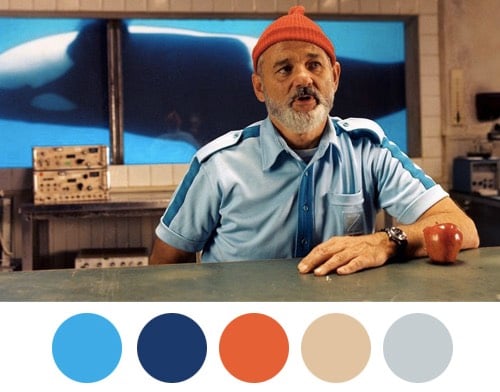
Stay Connected